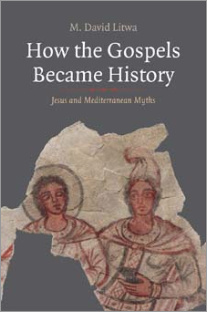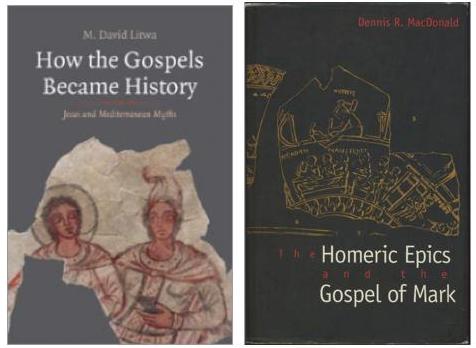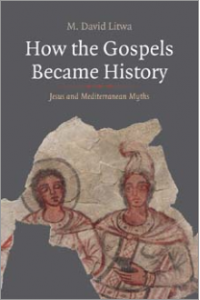 We now come to the most interesting chapters of M. David Litwa’s How the Gospels Became History: Jesus and Mediterranean Myths. We are no longer distracted by protests against those who would deny the historicity of Jesus or, at least not directly, protests against scholars who posit that the evangelists directly imitated Homer. The title of chapter 3 is “Incarnation” and here Litwa enlightens readers to the first-century context of how readers might have understood the very idea of a god appearing in the world in flesh as a human being. To be fair, though, Litwa intends to demonstrate more than this ancient world-view. Litwa also attempts to demonstrate how the evangelists presented the idea of god’s incarnation as plausible history.
We now come to the most interesting chapters of M. David Litwa’s How the Gospels Became History: Jesus and Mediterranean Myths. We are no longer distracted by protests against those who would deny the historicity of Jesus or, at least not directly, protests against scholars who posit that the evangelists directly imitated Homer. The title of chapter 3 is “Incarnation” and here Litwa enlightens readers to the first-century context of how readers might have understood the very idea of a god appearing in the world in flesh as a human being. To be fair, though, Litwa intends to demonstrate more than this ancient world-view. Litwa also attempts to demonstrate how the evangelists presented the idea of god’s incarnation as plausible history.
Litwa begins with the Gospel of John and right from the start pulls me up with notions that may be old-hat to others but that were noteworthy to me: in the Gospel of John Jesus is never shown to be eating but he does tell others to eat him (or eat his flesh) and similar ideas. So what does “incarnation” mean to the fourth evangelist? Interesting question.
Sent into the world
Moving on, Litwa informs/reminds readers that just as biblical Wisdom was driven away when she tried to dwell among men so the Greek goddess of Justice, likewise, was driven from the unjust world of humanity. But the more detailed comparisons come with Hermes (the Roman Mercury) who was also known as the Logos, the interpreter of the high god Zeus, and messenger from Zeus to mortals. Litwa points to several messenger and creative roles of Hermes but focusses on Hermes assumption of a human body in his errands. We saw one of these roles when recently discussing M. David Litwa’s criticisms of Dennis MacDonald’s thesis. The god Hermes swept down from Mount Olympus to meet and escort the Trojan Priam on his dangerous quest to enter the Greek camp and request the return of the body of his slain son Hector. There Hermes took on the form of a young warrior capable of winning the trust of Priam and safely escorting him to the Greek camp.
Augustus Caesar: Mercury in the flesh
But Litwa informs us that Hermes — as the Roman Mercury — was subsequently portrayed by a Roman poet (Horace) as appearing on earth in the body of Augustus Caesar.
Then there is the ancient Greek philosopher Pythagoras. Litwa carries us through the biographers who lead readers to understand that the great thinker was also a “god who had come to earth”:
Iamblichus reported a Pythagorean creedal question (akousma) with its correct answer: ‘“Who are you Pythagoras?’ For they confess that he is the Hyperborean Apollo.” (Litwa, 69)
Pythagoras: Apollo in the flesh
But from here Litwa becomes more interesting still. Pythagoras revealed his true divine identity (i.e. the god Apollo in the flesh) to one selected follower, Abaris. Pythagoras took Abaris aside to show him, privately, that he had a thigh of pure gold — an unequivocal proof that he was truly a god. Later, at an Olympic Games, Pythagoras was reported by many eyewitnesses as having accidentally revealed the same golden thigh, thus proving to multitudes his divine nature.
Litwa reasonably draws a comparison with Jesus’ private revelation to Peter that he is indeed the Messiah. And this is, of course, reinforced by Jesus demonstrating the fact by the visible transformation of his body in the Transfiguration (as Pythagoras showed his golden thigh) to his select few followers. Litwa’s point, however, is more than mere revelation. Litwa argues that it is the quotidian, the prosaic, the mundane commonplace setting that goes some way to transforming the myth into “plausible history”.
The revelation and transfiguration take place at a well-known urban centre, Caesarea Philippi, and on a nearby mountain. Peter fumbles for words and says something quite silly so readers are clear that he is taken completely by surprise as any mere mortal would be. Litwa compares this circumstantial detail with the ordinariness of details surrounding Pythagoras’s revelation to Abaris. The Gospel of Luke even goes one step further by depicting the disciples as sleeping and needing to be awoken when Jesus’ body is transformed. Sleep, waking up, saying silly things, a well-known city and mountain — all of this context sets the revelation into a “plausible” or “historically sounding” context, according to Litwa.
I am not so sure, however. To return to the scene of Hermes being sent by Zeus to escort Priam, we read in Homer the following. Hermes descends as commanded by Zeus but the details of his meeting with Priam are also very prosaic, as the highlighted words surely indicate:
With this wand in his hand the mighty [Hermes] made his flight and soon reached Troyland and the Hellespont. There he proceeded on foot, looking like a young prince at that most charming age when the beard first starts to grow.
Meanwhile the [Priam and his herald] had driven past the great barrow of Ilus and stopped their mules and horses for a drink at the river. Everything as dark by now, and it was not till Hermes was quite close to them that the herald looked up and saw him. He at once turned round to Priam and said: ‘Look, your majesty; we must beware. I see a man, and I am afraid we may be butchered. Let us make our escape in the chariot, or if not that, fall at his knees and implore his mercy.’ –
The old man [Priam] was dumbfounded and filled with terror; the hairs stood up on his supple limbs; he was rooted to the spot and could not say a word. But the [Hermes] did not wait to be accosted. He went straight up to Priam, took him by the hand . . . . [Iliad 24]
Yet no critic of Homer in later centuries (including the time the gospels were written) thought of Homer as writing more than poetry. Even if the Trojan War were thought to be history and Homer its historian, the universal opinion was that Homer wrote the story in terms of poetic myth. Mundane details may have contextualized the mythical encounters of humans and gods, but they did not demonstrate the “historical truth” of such encounters.
But questioning Litwa’s thesis is a secondary focus of mine. What fascinates me most is the broader cultural context of the ideas or motifs we find in the gospels in the first or second centuries CE. Upcoming — Litwa’s discussions of genealogies and divine conceptions.
To order a copy of How the Gospels Became History: Jesus and Mediterranean Myths at the Footprint Books Website with a 15% discount click here or visit www.footprint.com.au
Please use discount voucher code BCLUB19 at the checkout to apply the discount.
Litwa, M. David. 2019. How the Gospels Became History: Jesus and Mediterranean Myths. New Haven, CT: Yale University Press.








